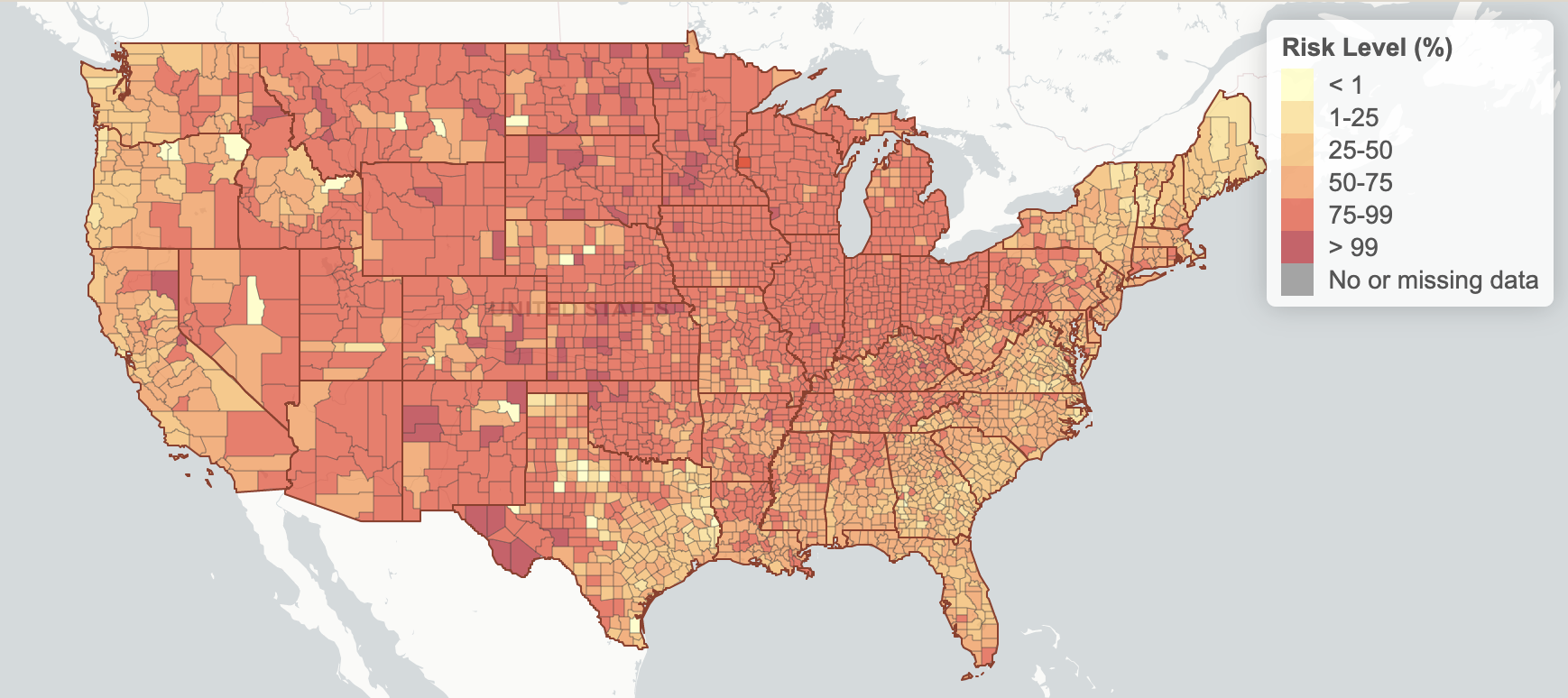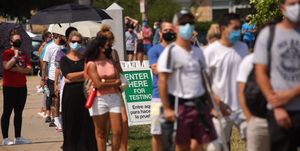- With the second wave of coronavirus surging across the country, experts say the safest thing to do is cancel travel plans and continue socializing outdoors.
- Experts say that the only way to truly decrease your COVID-19 risk is to wear a mask, socially distance, and get tested.
- While regular testing is a good idea, many states don’t have enough kits to go around. Here’s when you should get tested if you don’t have symptoms.
This winter, you might be asking yourself, “Do I need a COVID test?” as gatherings move indoors and the holiday travel rush kicks off.
With the second wave of coronavirus surging across the country, experts say the absolute safest thing to do is cancel travel plans and continue trying to socialize outdoors. But that’s not always possible. That’s where testing comes in.
Some schools and workplaces are open thanks to serial rapid COVID-19 testing. But while regular testing is a good idea, many states don’t have enough kits to go around.
Even if you don’t have COVID symptoms like a loss of taste or smell, coughing, or fever, you might still have the virus and can spread it to others. So it’s important to continue wearing a mask and social distancing. That’s because you could be asymptomatic (you have the virus but never develop symptoms) or presymptomatic (you’re COVID-positive, but your symptoms haven’t shown up yet).
Amesh Adalja, MD, senior scholar at the Johns Hopkins Center for Health Security says presymptomatic spread “may be responsible for a significant proportion of transmission.” (One study showed that up to 44 percent of transmission could be from presymptomatic or asymptomatic patients.)
The only way to know for sure whether you have asymptomatic or presymptomatic COVID is by getting tested. We spoke to experts about a few different situations where you’ll need to get tested if you don’t have symptoms.
Should you get tested if you came into contact with a person who has COVID-19?
Yes. “You should get tested [immediately] if you become symptomatic,” says Dr. Adalja. If you don’t have symptoms, you should quarantine and get tested around day five after exposure. If you test negative and have no symptoms, you can shorten your quarantine time from 10 days to seven days, per new guidance from the Centers for Disease Control.

It’s really important that you wait at least five days from the day of exposure to get that test,” says Dr. Susan Butler-Wu, PhD, associate professor of clinical pathology at the Keck School of Medicine at the University of Southern California. On days one to four after exposure, you’re presymptomatic, which means that you might be able to spread the virus, even though the virus can be present at low levels that won’t always show up on a test.
However, it’s possible to develop COVID symptoms up to 14 days after exposure. You should continue monitoring yourself for COVID symptoms, wear a mask, and practice social distancing. If you develop coronavirus symptoms like the ones listed below, Dr. Butler-Wu says, “there would be a real concern that it could be COVID” due to that same initial exposure. In that case, she says, “you would need to test again,” and start self-isolating again.
These are the COVID symptoms you should watch for, per the CDC:
- Fever or chills
- Cough
- Shortness of breath or difficulty breathing
- Fatigue
- Muscle or body aches
- Headache
- New loss of taste or smell
- Sore throat
- Congestion or runny nose
- Nausea or vomiting
- Diarrhea
What happens if you test positive for COVID-19?
If you test positive, Dr. Adalja says, “you should self-isolate for a period of 10 days from the date of their test, answer the phone when the Health Department calls, and notify people you were in contact with from the two days prior to the positive test onward.”
If you continue to have symptoms after 10 days, you should continue to quarantine until you go 24 hours “with no fever without the use of fever-reducing medications,” per the CDC.
Should you get tested if you have not come into contact with a person who has COVID, but you’re planning to visit family for the holidays?
Get tested, and then be extremely careful while traveling. “Testing is only one thing you should be doing. It’s not a substitute for social distancing and wearing a mask,” Dr. Adalja says. “Some people have used testing to decrease risk, but it’s not ironclad. You could be incubating [when you get tested] and then test positive later.”
The only way to use testing to decrease risk is “repeat serial testing,” or getting tested every three days or so, per the CDC. “Eventually we may get home tests where people could test every day or twice a week, but we’re not quite there yet,” he says.
Dr. Butler-Wu believes people should reconsider traveling. “I don’t want to sound dogmatic or preachy, but these are the facts: when you get tested, it’s a snapshot at that moment in time.” If you’re getting on a plane, you’re likely getting tested a day or a few days before getting on the plane. Not to mention, you might get exposed to COVID while traveling.“I worry about people feeling like a negative test means they’re not infectious.”
Instead, a negative test means that you’re not likely to have been infectious the moment you were sampled. A negative test does not mean you can’t contract the virus. “A negative result doesn’t mean you’re out of the woods, and a negative test doesn’t mean you’re not infectious,” adds Dr. Butler-Wu.
“The more important thing is trying to decrease your contacts [or self-isolate] prior to that travel, and still also be very meticulous about hand hygiene and masking,” Dr. Adalja says. “You can use a test to decrease the risk even further,” but testing alone is not enough to bring your risk to zero.
Should you get tested if you have not come into contact with a person who has COVID, but you “just want to be safe” with rising cases?
It’s not a bad idea if there are enough tests in your area. Some communities like New York City are encouraging everyone to get tested often, no matter what. But it depends on where you live, and the best thing to do is consult your doctor, local health department, or urgent care clinic.
“Here’s the thing: there are a finite number of tests in the system. That system is really running to capacity. If you live in an area where there’s an abundance of tests and the community surveillance programs are able to handle the volume,” that’s different than if your local testing system is totally overwhelmed and there’s a five-day wait for results, Dr. Butler-Wu says.
She also thinks everyone should consider why they are getting tested in the first place. “Are you basically getting tested ‘to be safe,’ in addition to all the other measures like social distancing and wearing a mask? Or, are you somebody who doesn’t want to wear a mask and went to a house party last weekend?” A negative test isn’t a green light to stop wearing a mask or stop social distancing.
That’s because the only way to truly decrease risk is to wear a mask, socially distance, and get tested. “The risks we take with ourselves are not just about us. The risks you take can have so many impacts on people that you will never meet,” like the case of the wedding in Maine that led to seven deaths of people who did not attend. “Obviously, people are really tired, but we can see the finish line in sight.”
Source: Read Full Article

